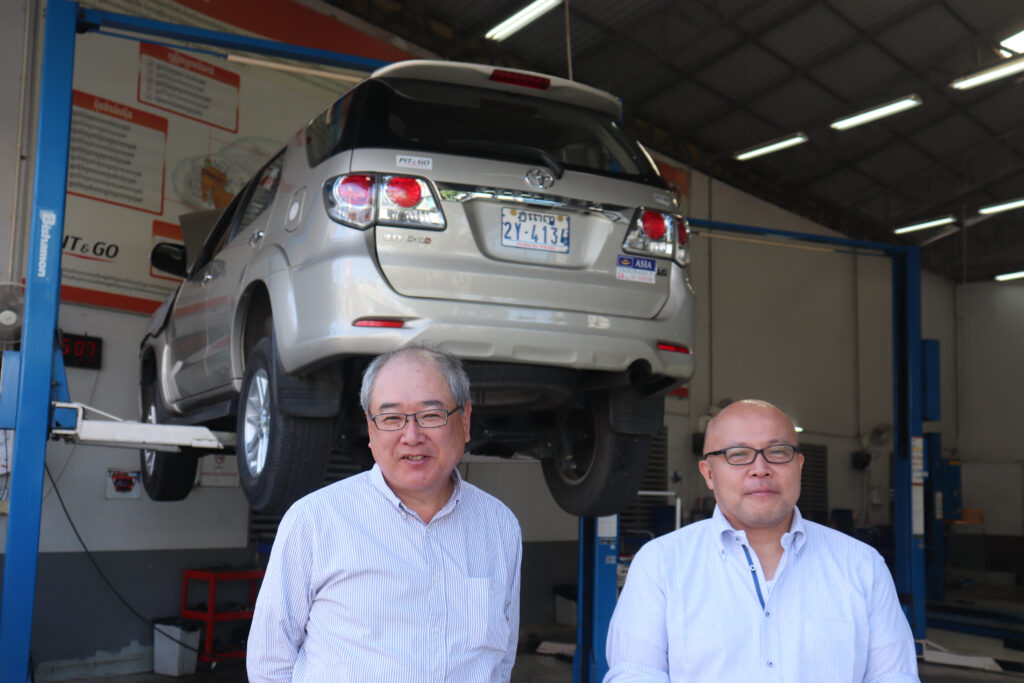PIT & GO Automotive Service (Cambodia) Co., Ltd.
Managing Director Mr. Tomoyuki Sugiura
– First of all, could you tell us about the strength and the selling point of your company?
Having Toyota at the head of the list, we do business with Denso, Aisin, and Toyota Tsusho, all of which make cars and parts, so we have technical strengths.
Also, Toyota has the know-how of operating a dealer with a longtime experience, so Toyota uses the know-how to not just operate a dealer but to operate a shop that customers can use with less feeling of hesitation than a dealer, making a good atmosphere. Toyota has great technical strength, too. We, Denso, and Aisin have commercial parts which are different from genuine parts but cheaper than them, so our selling points would be “good atmosphere of the shop”, “parts” and “technical strength”.
– How do you think about some local repair shops that repair cars at a surprisingly low price?
Those shops are needed, too. There are people who want good service, even if it is a little bit expensive, whereas there are also people who want the prices as cheap as possible. Therefore, we have been making our shop for those who could pay a bit more for good service, wait in a good atmosphere while repairing, which various choices of services.
– Is the priority of customers different between Japan and Cambodia?
I think so. In Japan, the most priority is “time”. The waiting time should be as short as possible. Therefore, almost all the repairs are with reservation, and all the work is done by the due date. That is the selling point of this kind of service in Japan. On the other hand, I think it is too soon to make “time” the biggest selling point in Cambodia, so we would like to concentrate on our technique and good service for now.
– Over the last few years, I see a lot of cars that I had not seen before in Cambodia. Does that make any change in the automotive service business?
In the past, the car was designed to be controlled separately such as with engine control and transmission control but nowadays integrated control device does everything with collected information stored on a single computer. Because of this change, the skill for diagnosing it is highly required for car mechanics. To meet this demand, our mechanics will have to take training so that they can detect errors and problems and fix them quickly. When you check cars in Cambodia, cars made in 2002 have the biggest number. They are 16-year-old cars so they could be scrapped in Japan. When your customer drives this old car, it’s hard to tell the owner that a part replacement costs JPY100,000. So we usually try to look for reasonable second-hand parts to make the cost cheaper. I bet customers who drive old cars want to avoid expensive repair bills. So what we do is we diagnose problems accurately and offer flexible options for part replacements.
– I suppose daily maintenance is very important for car owners. How much do they know about it?
Not so much, to be honest. Even truck drivers and drivers who drive a car for their work don’t know enough. Speaking of how cars are made, cars and car parts have life expectancy but they are overused way beyond the limits in Cambodia. It should be hard to believe for people in Japan that cars get broken so easily and it actually doesn’t happen much but it is a different story if they are overused. As there are so many cars that have been used for a long time and people are used to seeing them, I guess not so much of them care about these things.
– What do you think is the market in Cambodia going
to be like?
Most second-hand cars here are imported from North America but if you look at neighboring countries, Vietnam’s stopped importing second-hand cars ten years ago and Myanmar’s stopped last year. It is their government policy that they don’t want to be a scrap factory of broken cars and want people to drive only safe cars. Some other neighboring countries allow second-hand cars but only the ones that have been used less than 3 years. What is common among them is that they want people to import relatively new, like less than years old, second-hand cars and drive them for 10 to 15 years. As of now, Cambodia doesn’t regulate importing second-hand cars so there’ll be more and more of them. I’m afraid I don’t think it’s a good thing for the country.
I guess if more people drive new cars, they might change their ideas but there’re not enough of them so second-hand cars will continue to be the popular choice for the time being.

